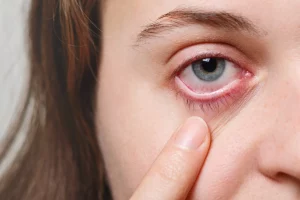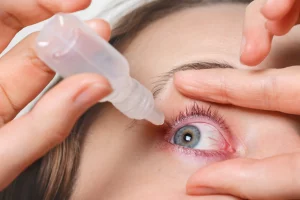Bacterial Conjunctivitis Symptoms – Bacterial conjunctivitis (BC) is an eye bacterial infection of the conjunctiva. This transparent membrane covers the eye’s white part and the eyelids’ inner surface. BC usually happens due to bacteria from the skin or nose coming into contact with the look. The most common cause of bacterial conjunctivitis is Staphylococcus aureus, although other bacteria, such as Streptococcus pneumonia and Haemophilus influenza, can also cause the condition.
People of all ages can get bacterial conjunctivitis, most commonly seen in children. Bacterial conjunctivitis symptoms include redness of the eye, increased tear production, and a pus-like discharge from the eye. The infection can cause the eyelids to stick together, especially when you first wake up in the morning. BC is usually a self-limited condition that will resolve within two weeks.

However, bacterial conjunctivitis can sometimes lead to more severe complications, such as corneal ulcers or scarring, so you must see your doctor if you think you may have the condition. Bacterial conjunctivitis treatment typically includes antibiotic eye drops or ointment. In some cases, oral antibiotics may also be necessary. It is essential to finish all the medication even if your symptoms have resolved to ensure that the infection is completely gone.
You should also avoid wearing contact lenses until your doctor has cleared you. If you have bacterial conjunctivitis, practicing good hygiene to prevent the infection’s spread to others, including washing your hands frequently and avoiding touching your eyes. You should also avoid sharing towels, makeup, or other personal items with others. Bacterial conjunctivitis is a common eye condition that doctors can treat effectively with antibiotics. However, you must see your doctor if you think you may need to ensure it becomes appropriately diagnosed and treated.
Causes and Diagnosing Eye Bacterial Infection
There are several different risk factors for bacterial conjunctivitis. One of the most important is age. Children are more likely to develop bacterial conjunctivitis than adults, although the condition can occur at any age. Other risk factors include:
- Having a weakened immune system: People with conditions that weaken the immune system, such as HIV/AIDS or cancer, are at increased risk of developing bacterial conjunctivitis.
- Pregnant women are also at increased risk of developing bacterial conjunctivitis.
- Contact lenses: People who wear contact lenses are more likely to develop bacterial conjunctivitis than those who do not because contact lenses can provide a route for bacteria to enter the eye.
- Having certain medical conditions that affect the eyes:
-Blepharitis: This is a condition that causes inflammation of the eyelids.
-Dry eye: This is a condition in which the eyes do not produce enough tears.
-Meibomian gland dysfunction: This condition affects the glands that produce oil for the tears.
-Diabetes: This condition can cause changes in the eye’s blood vessels, making it easier for bacteria to enter.

Another common factor is bacteria from the skin or nose coming into contact with the eye, which can happen when you touch your eyes with contaminated hands or if you have an infection in your nose, such as a sinus infection that spreads to your eyes. Bacterial conjunctivitis can also occur after exposure to certain chemicals, such as chlorine in swimming pools, or after injury to the eye. In some cases, it may happen due to a reaction to eye drops or other medications.
These are just a few potential risk factors for developing bacterial conjunctivitis.
If you think you may have bacterial conjunctivitis, it is essential to see your doctor so that they can properly diagnose and treat the condition. Diagnosing bacterial conjunctivitis typically starts with a medical history and physical examination of the eyes. Your doctor will ask about your symptoms and any other health conditions you may have. They will also want to know if you have any risk factors for the disease, such as wearing contact lenses or having a weakened immune system.
A doctor will perform a physical examination of the eyes to look for signs of infection, such as redness, swelling, or discharge. Sometimes, a doctor may take a sample of the release from the eye for laboratory testing, which can help to identify the specific type of bacteria causing the infection. Treatment for bacterial conjunctivitis typically involves antibiotics. These can be given as eye drops, ointments, or pills. In most cases, symptoms will improve within a few days of starting treatment. However, it is essential to finish the entire course of antibiotics to ensure the infection is completely gone.
Bacterial Conjunctivitis Symptoms and Complications
The symptoms of bacterial conjunctivitis can vary depending on the specific bacteria causing the infection. However, some common symptoms are associated with the condition. These include:
-Redness in the eyes
-Swelling of the eyes
-Itching or burning sensation in the eyes
-Discharge from the eyes that is thick and pus-like: This discharge can cause the eyes to stick together, especially when you wake up in the morning.
-Sensitivity to light: This symptom may be more severe in cases of viral conjunctivitis.
-Blurred vision: This symptom may be more severe in cases of viral conjunctivitis.
If you experience any of these symptoms, it is essential to see your doctor so that they can properly diagnose and treat the condition. Bacterial conjunctivitis is a common eye condition that a doctor can usually treat effectively with antibiotics.
In most cases, bacterial conjunctivitis is a mild condition that will improve within a few days of starting treatment. However, some potential complications can occur in severe cases. These include:
-Corneal ulcers: This is an open sore on the eye’s surface. If left untreated, a corneal ulcer can lead to vision loss.
-Orbital cellulitis: This is an infection of the tissues around the eye. Orbital cellulitis can be severe and may require hospitalization.
-Vision loss: In rare cases, vision loss can occur if the infection spreads to other eye parts.
Bacterial Conjunctivitis Treatment
Bacterial conjunctivitis treatment usually includes antibiotics. These can be given as eye drops, ointments, or pills. In most cases, symptoms will improve within a few days of starting treatment. However, it is crucial to finish the entire course of antibiotics to ensure the infection is completely gone.

A few different types of antibiotics can treat bacterial conjunctivitis. The specific kind used will depend on the particular bacteria causing the infection. Some common antibiotics used include:
-Erythromycin: This antibiotic is available in ointment and eye drop forms. It is typically used four times per day for 5 to 7 days.
-Azithromycin: This antibiotic is available in pill and eye drop forms. It generally is used once per day for 3 to 5 days.
-Ofloxacin: This antibiotic is available in pill and eye drop forms. It is usually used twice per day for seven days.
-Levofloxacin: This antibiotic is available in pill and eye drop form. It is typically used once per day for 5 to 7 days.
You should also avoid wearing contact lenses until the infection completely clears up, which will help prevent spreading bacteria to other people. If you wear disposable contact lenses, you should throw them away and use a new pair when the infection has cleared up.
Your doctor will determine the best course of treatment based on the specific bacteria causing your infection. The disease will usually clear up within a few days of starting antibiotics. However, it is essential to finish the entire treatment course to ensure the infection does not return.
Preventing Eye Bacterial Infection
There are several things you can do to help prevent bacterial conjunctivitis. One of the most important is to practice good hygiene, which includes washing your hands frequently and avoiding touching your eyes. You should also avoid sharing towels, makeup, or other personal items with others. It is also essential to clean contact lenses properly and to replace them regularly.
How to properly clean contact lenses
It is essential to clean your contact lenses properly to prevent bacterial conjunctivitis. There are two main types of contact lenses: disposable and reusable. It would help if you threw disposable lenses away after each use. Reusable lenses should be cleaned with a particular solution and stored in a clean case.
Here are some tips for cleaning your contact lenses:
-Wash your hands before handling your lenses.
-Use mild soap and water to clean your lenses.
-Rinse your lenses thoroughly with sterile saline solution.
-Store your lenses in a clean case filled with fresh solution.
-Replace your lens case every three months.
Following these tips can help you prevent bacterial conjunctivitis and other eye infections. Ask your doctor or optometrist if you have any questions about cleaning your lenses properly.
If you have a weakened immune system, avoiding exposure to bacteria and viruses is vital.
- Avoiding crowds: One of the best ways to prevent exposure to bacteria and viruses is to avoid crowds, which is especially important during peak cold and flu season.
- Washing your hands: Washing your hands regularly is one of the best ways to prevent infection. Be sure to clean with soap and water for at least 20 seconds.
- Avoid touching your face: Touching your eyes, nose, or mouth can introduce bacteria and viruses into your system. It is essential to avoid doing this as much as possible.
- Disinfecting surfaces: Bacteria and viruses can live on surfaces for hours or even days. To help prevent infection, it is essential to clean and disinfect surfaces regularly.
- Getting vaccinations: One of the best ways to prevent infection is to get vaccinated. Vaccines help your body build immunity against bacteria and viruses.


